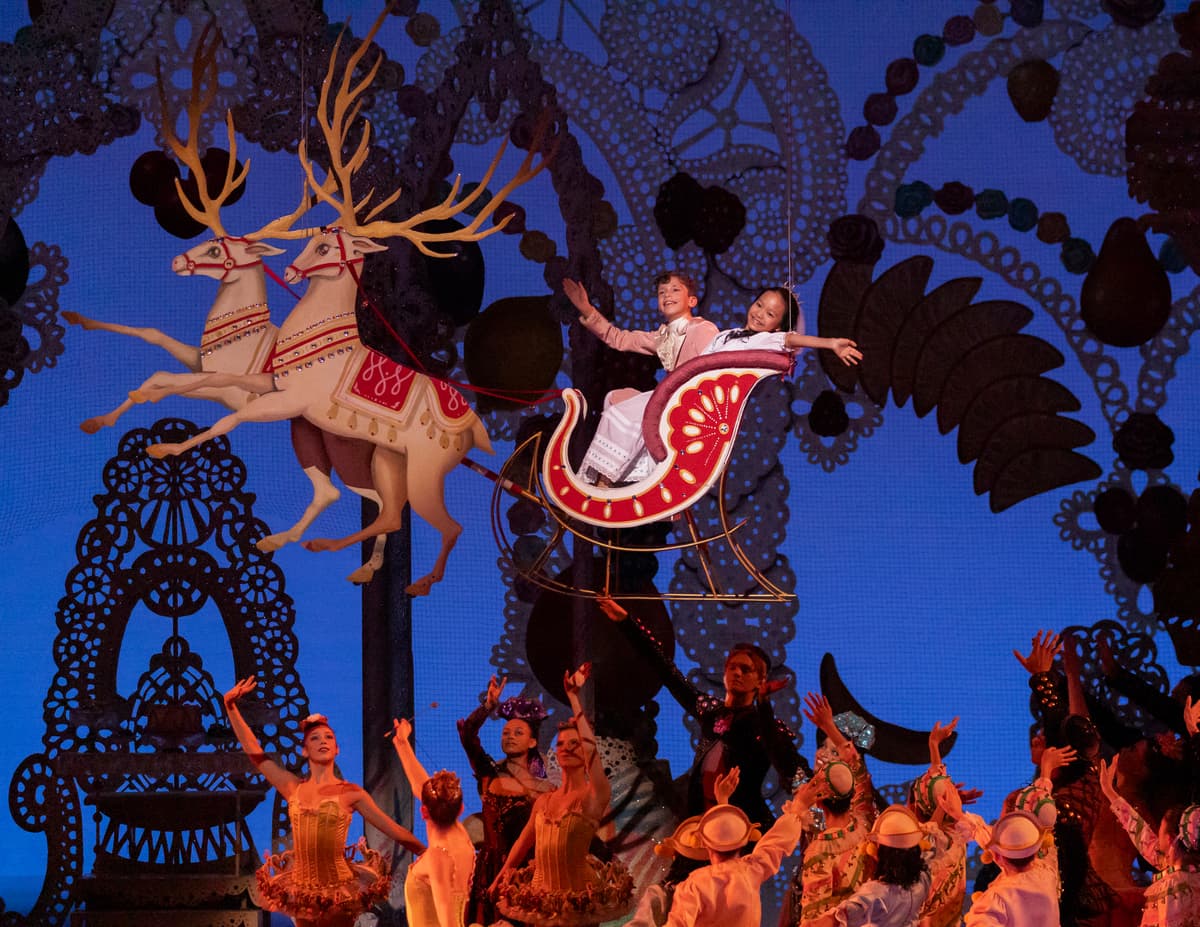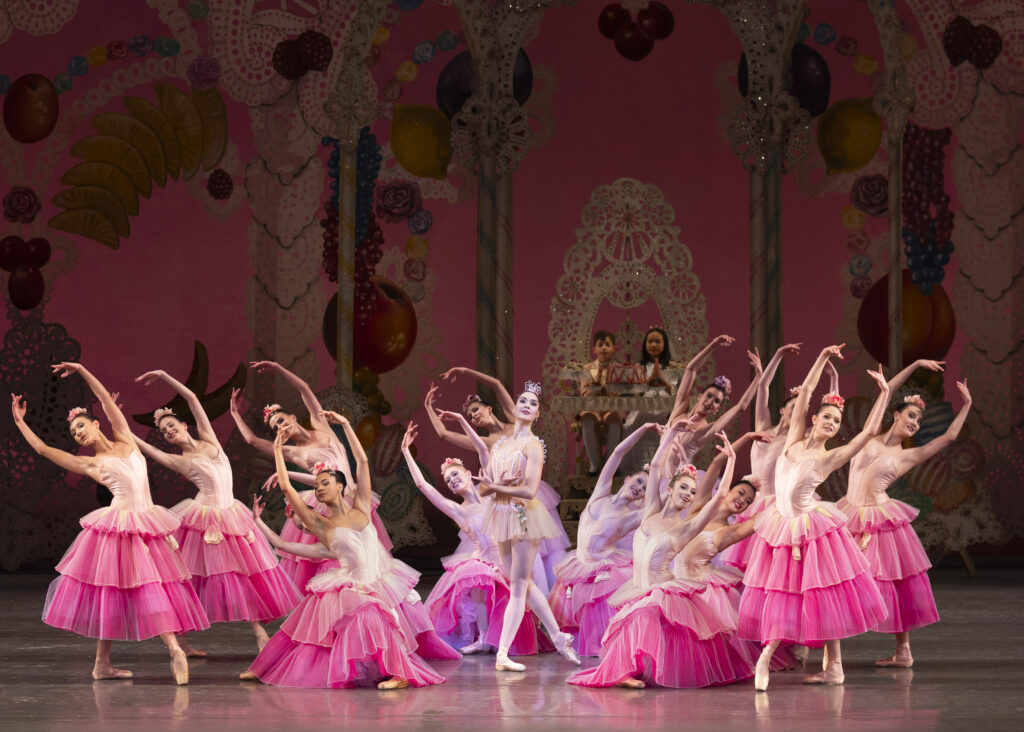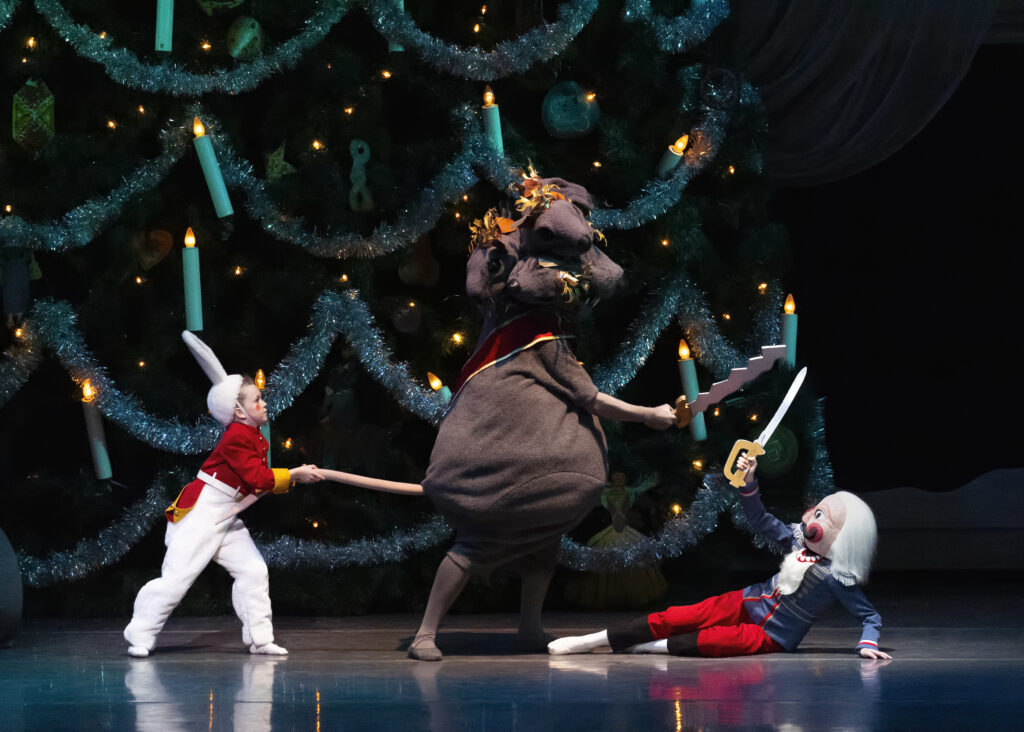‘The Nutcracker’ Celebrates Its 75th Year and Enthralls Generations of Dancers at the New York City Ballet
‘It’s a very full circle moment,’ say the stars who once danced in the show as children.

“Magic” — to inspire it in audience members and dancers of all ages is the perennial achievement of “The Nutcracker” at the New York City Ballet as it celebrates its 75th anniversary this year.
When the sparkling Christmas tree on stage soars to forty feet, children in the audience gasp. Some even shed a tear. The Nutcracker toy, gifted to the tale’s heroine, Marie, during the opening party scene, soon comes to life as a little prince. What follows in choreographer George Balanchine’s two-act staging, performed every year since 1954, is a series of fantastical events and curious characters in the dreamworld of Marie and her prince.
While awe abounds in the audience, so too, are the starlets on stage inspired, some of whom have been dancing in the show for more than a decade. “There’s this entry point into the world of ballet through the eyes of Marie,” a dancer in NYCB’s corps de ballet who plays the role “Coffee” this season, Christina Clark, tells me in a conversation over coffee — fittingly — near the company’s Lincoln Center theater.
“As a child, the magic of the Nutcracker is really what brings you in,” says Ms. Clark. To this day, she never fails to catch a glimpse of the sky-high Christmas tree from the TV monitors backstage. “I watch the tree grow every single time,” she says, smiling, “because you really think it’s going to stop, and then it just keeps going.”
A hallmark of the beloved production is its roster of 126 children, between the ages of seven and 13, who all study in the official school of NYCB, the School of American Ballet, where I once trained as a student. A handful of those young dancers will move up through the ranks of SAB and be invited to join the storied company and go on pointe as a profession.

Ms. Clarks recalls watching “The Nutcracker” at age three and, enthralled by the leaping children before her, asking her mother, “how do I get to do that?” She joined SAB at age 7, performed in “The Nutcracker”’s party scene and as an angel a year later, and as she rose up the ladder, took on a variety of roles as “Divertissements” in Act II’s “Land of Sweets.”
The scene that arrests me most is the “Waltz of the Snowflakes” at the end of Act I. Sixteen corps de ballet women leap in a snowy forest as cascading confetti graces their ice-blue dresses. Composer Pyotr Tchaikovsky’s silky symphony emanates from the interplay of clarinets, flutes, harps, oboes and trumpets in the pit of the orchestra below.
“It takes you into another world,” one Snowflake, Rommie Tomasini, says of this scene, who also plays the roles of “Tea” and “Toys” this season. She has performed as a plethora of characters in the show since she was seven, including starring as Marie for two years. Dancing it today comes as easy as breathing. “The music,” she tells me, “is engraved in your body.”

Yet while sparkling like a fresh fall of snow, the dancers are doing sport on stage. “The snow scene is one of the most cardio intense exercises,” Ms. Clark, a former Snowflake, says. “On stage at the end, everyone is really breathing.” Some even cough up flecks of confetti. That test of athleticism is characteristic of Balanchine’s choreography, which demands its dancers to jump high and silently and move quickly, yet sharply.
The show is not only physically engaging, but also creatively dynamic. The role of “Coffee” allows its dancer an opportunity for individual interpretation rare in the highly-choreographed craft of ballet. Whether it’s in the articulation of the arms or clink of the finger symbols, “you can make up something totally different within the realm of that character and flavor of the dance,” says Ms. Clark, who dominates the stage under a single spotlight during the dance.
The first time she performed the role last season, she felt like she “was underwater or in my own world,” Ms. Clark says. “I’m finding more and more this year that I feel more settled in who I want to be in the role and what I want to put out there.”
When Ms. Tomasini plays the role of a wind-up doll during the party scene, viewers are left incredulous as Ms. Clark pops out of a small gift box and bursts into dance. When I ask her if she indeed squeezes into that box, she declines to tell her secret, saying, “that’s ruining the magic!”
Some of that magic lies beyond where the viewer can see. “There’s a lot of different energies that are mingling together in the wings,” Ms. Clark says, which is “a liminal space between your dressing room and the stage.” In other productions, dancers might be on edge as they practice their steps before jumping under the spotlight, but in “The Nutcracker,” the scurrying children backstage bring a sense of joy.
“We try to make it as fun as possible because we’ve got 50 shows of it,” Ms. Tomasini says. “You’ve got to try and somehow keep it fresh.” She befriends the children backstage, recalling the excitement she once felt when an older dancer spoke to her. “Those people that I looked up to so much, I dance with them now. They’re my colleagues,” Ms. Tomasini says. Yet, to her, “they will always be and they still are my superheroes, my superstars.”
“Occasionally, someone will do something on stage that’s so amazing and good,” Ms. Clark says, “we’ll start clapping in the wings even before the audience starts clapping” — loud enough that stagement management has to shush the dancers.
Many of the NYCB dancers spent their formative years of childhood as students at SAB together. “It’s a very full circle moment,” Ms. Clark says. “I was once that kid standing and looking at the older dancers and just wishing that one day, that could be me.”
Just as that awe-struck feeling has yet to fade away, so too, do the lessons of their older mentors prevail. “It is as if you are wearing a Cartier necklace,” a NYCB prodigy of Balanchine and former SAB teacher, Garielle Whittle, told Ms. Clark as a young girl to encourage her to bring her chest outward. “I think of it still,” she recalls, “especially on stage, because you want to exude confidence and catch the light.”
“Pretend you are balancing a wine glass on your heel,” I remember Ms. Whittle telling students while we extended our legs in arabesque. “Pretend a string is pulling at the top of your head,” she’d say to correct the young dancers’ posture.
“Make sure you always have that little sparkle,” another former NYCB principal, Katrina Killian, would tell Ms. Tomasini as she advanced through the ranks of SAB. “Everybody in the company has the technique and the amenities to be a ballet dancer,” Ms. Tomasini says. “But it’s that extra little sparkle that’s going to get you somewhere, and it’s also going to make you feel the best about yourself.”

